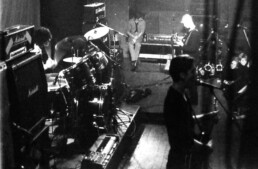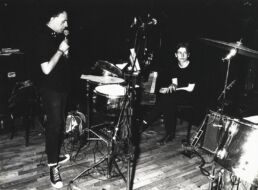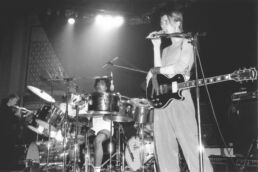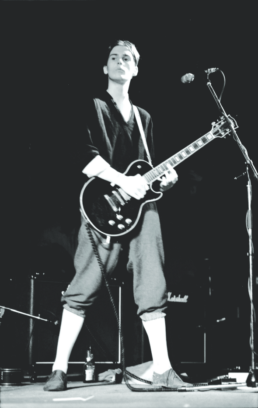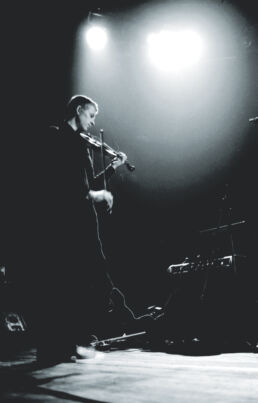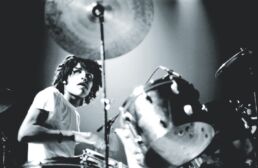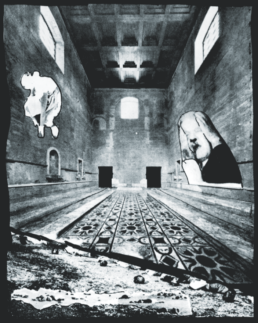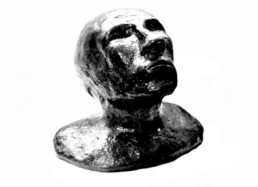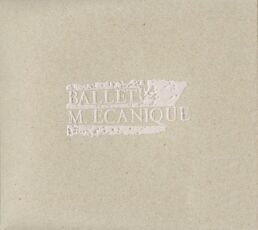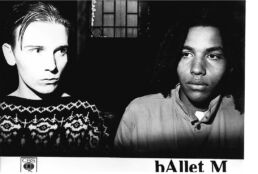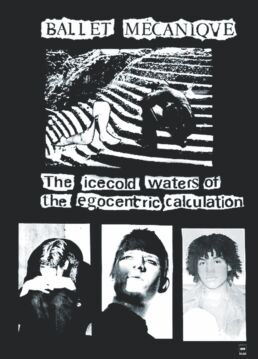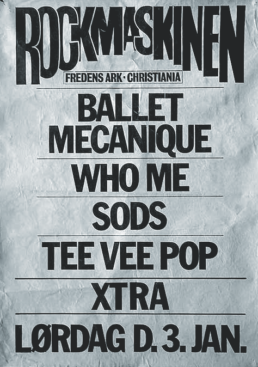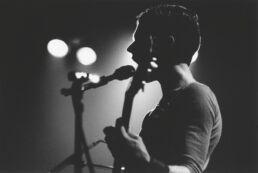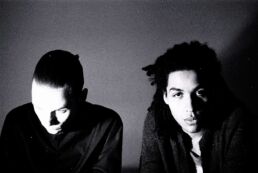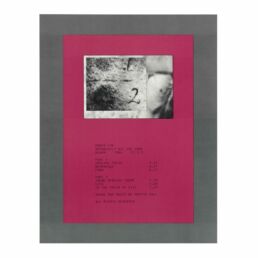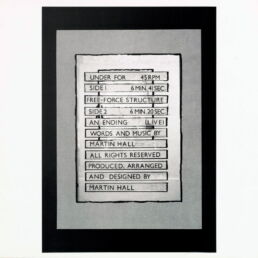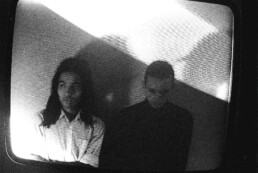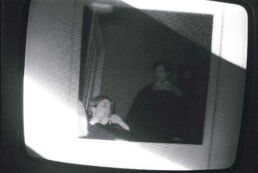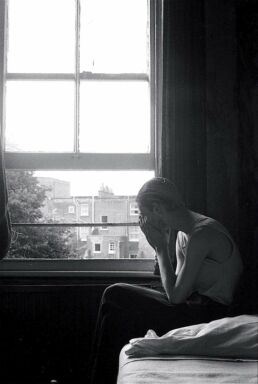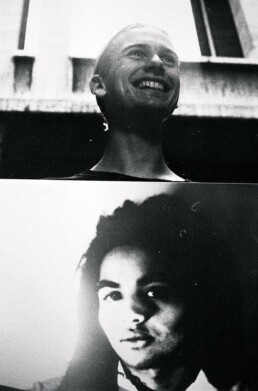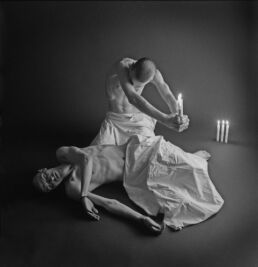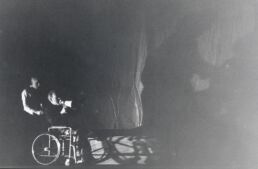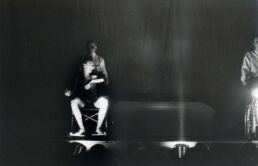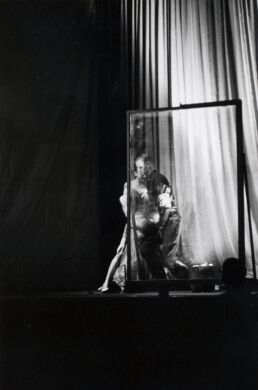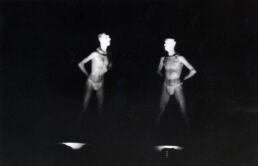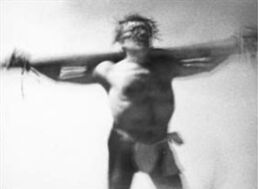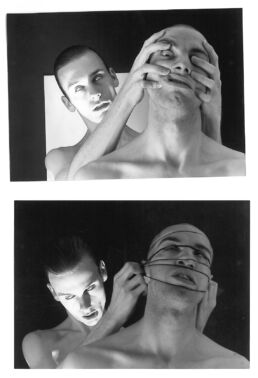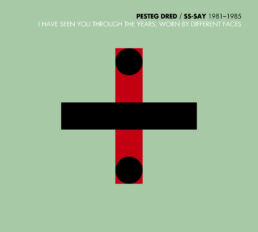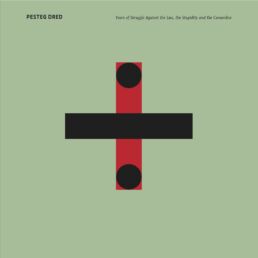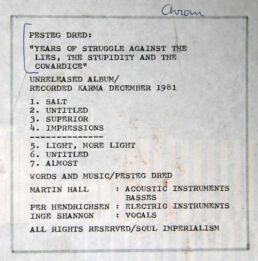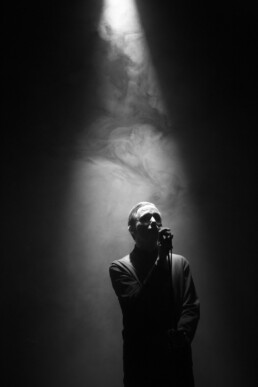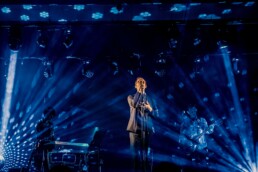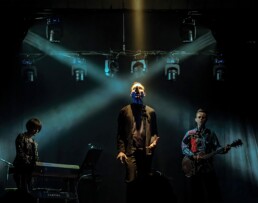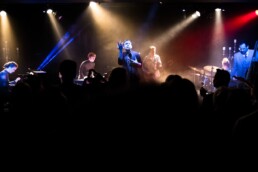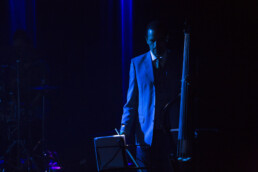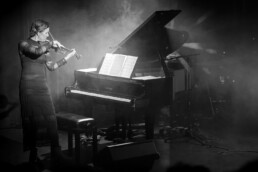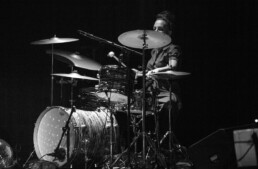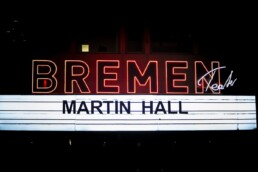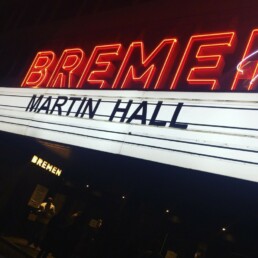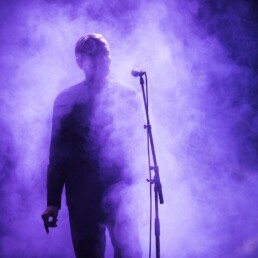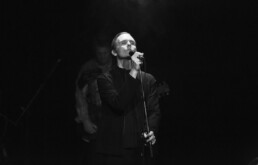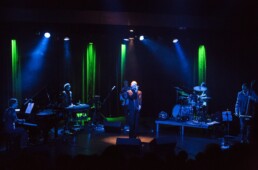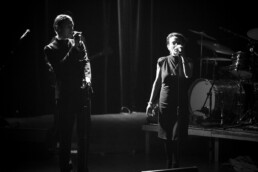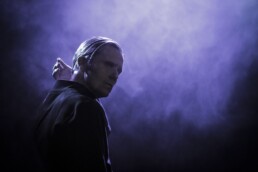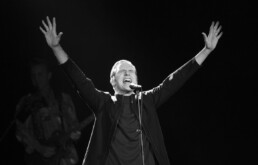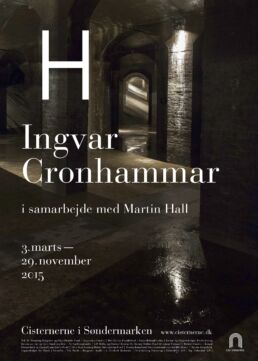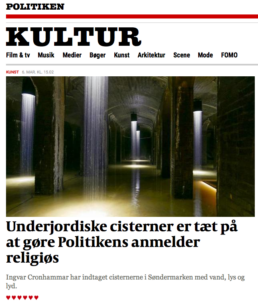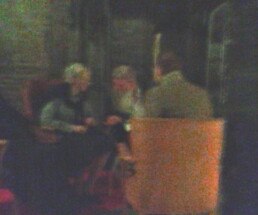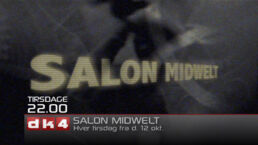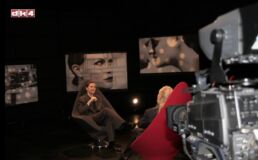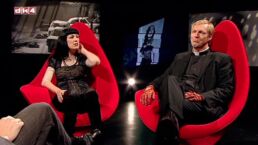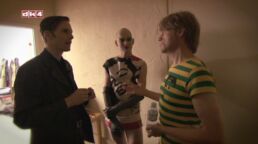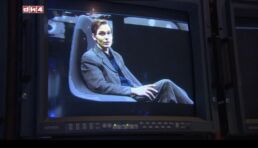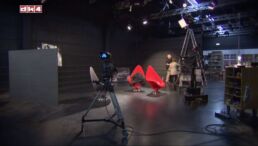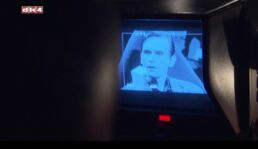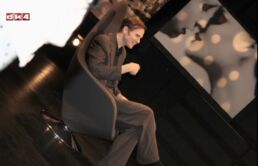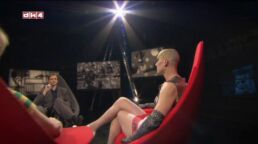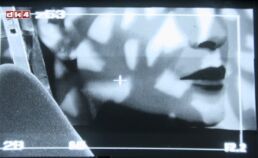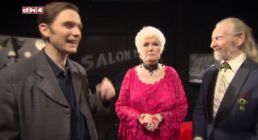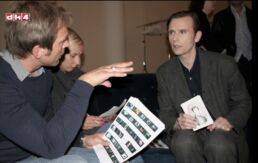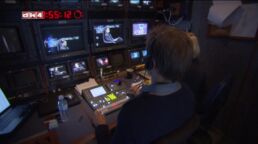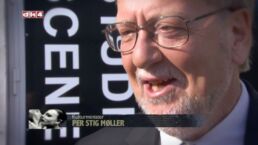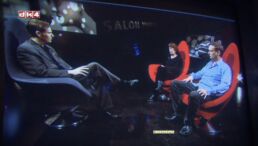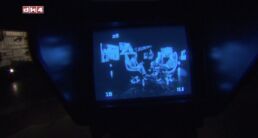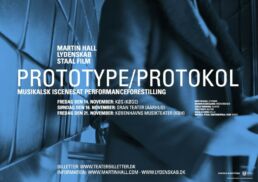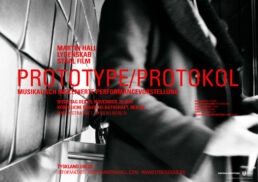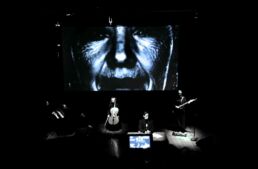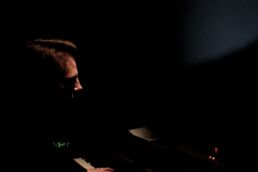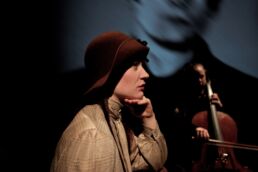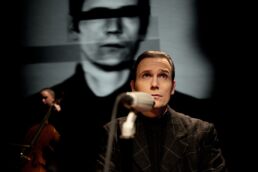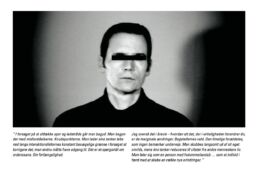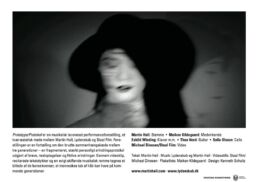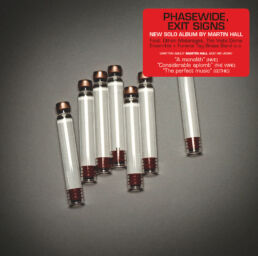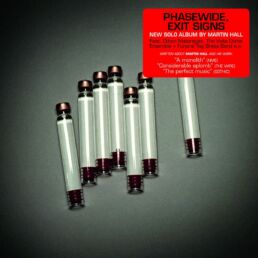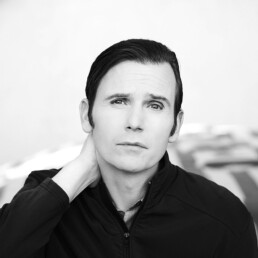FEATURES
BALLET MÉCANIQUE
BALLET MÉCANIQUE
Ballet Mécanique released their first single Avenues of Oblivion in May 1980. The group’s debut album The Icecold Waters of the Egocentric Calculation came out in September 1981 and the group’s second and final album For was released in October 1982 after which Martin Hall reconstituted the group as Under For.
Ballet Mécanique synthesized rock, avant-garde and poetry in an at the time unheard way, using dancers, slides and films at their concerts to create their own surrealistic ecology on stage. Their impact on Danish contemporary culture was significant.
The Icecold Waters of the Egocentric Calculation was instantly proclaimed to be a work of historical proportions and the title still figures on lists such as the illustrious Danish rock encyclopedia Politiken’s Rockleksikon’s chart over the 50 most important releases in Danish rock.
Ballet Mécanique, Fortropper 24-25-26/4/1981
Photo: Torben Voigt
Ballet Mécanique, Odd Fellow Palæet 11/6/1981
Photo: Gorm Valentin
Martin Hall, Roskilde Festival 27/6/1981
Photo: Søren Svendsen
Morten Versner, Roskilde Festival 27/6/1981
Photo: Søren Svendsen
Michael Karshøj, Roskilde Festival 27/6/1981
Photo: Søren Svendsen
Album artwork 1981
Design: Martin Hall
Album artwork 1981
Sculpture: Morten Versner
Ballet Mécanique, Nosferatu Festival 7/3/1982
Photo: Ole Dreyer
The Icecold Waters of the Egocentric Calculation 2006
Design: Martin Hall
UNDER FOR
UNDER FOR
Under For was Martin Hall’s continuation of his Ballet Mécanique project after this group split up in 1982. Hall and drummer Michael Karshøj then joined forces with avant-garde guitarist Per Hendrichsen who Hall had been working in Pesteg Dred.
Under For only released one studio album, Apparently All the Same (1984), yet this title remains one of Hall’s most significant releases during the eighties. The group’s legendary concert at the classical festival ISCM World Music Days in October 1983 is included on the 2009 special edition of the album.
Apparently All the Same was one of the few Scandinavian releases from the period that was praised by British music magazines such as New Musical Express and Sounds. In October 1984 Under For also released the 12” single Free-Force Structure, a single that received a favourable review in NME as well. Furthermore Under For appeared in Claus Bohm’s film Totem from the same year.
A reproduction of the Danish indie magazine SAM NYT’s Under For feature 1984 is available here.
Apparently All the Same 1984
Design: Martin Hall
Free-Force Structure 12″ single 1984
Design: Martin Hal
Michael Karshøj and Martin Hall 1984
Photo: Henrik Möll
Lena Walsh and Per Hendrichsen 1983
Photo: Martin Hall
Martin Hall 1983
Photo: Lena Walsh
Martin Hall 1983 and Michael Karshøj 1984
Photos: Jacob Thuesen/Henrik Möll
PARADE
PARADE
Parade was a multimedia performance, an experimental theatre project performed by The Body Art Ensemble of Copenhagen, Martin Hall’s continuation of his 1982 outfit The Art Ensemble of Copenhagen. Hall’s partner in The Body Art Ensemble of Copenhagen was Henrik Möll.
Parade was written and directed Hall and performed over two nights at Saltlageret (a legendary venue in Copenhagen) in December 1984. At these shows Hall and Möll engaged in quite severe self-mutilation on stage (such as cutting themselves open) while films were projected with the two leading actors performing oral sex on each other. As far as Hall and Möll were concerned recitations were made solely via pre-recorded messages (mono- and dialogues) played from handheld walkman equipment on stage – all other narrative activity was made as either playback speak or performed live by the other actors via megaphones.
The show’s cast featured Jan Munkvad, Asger Gottlieb, Janine Neble and Jens Kruse. Last but not least, Martin Hall’s father, Eigil Hall, also appeared on stage, playing both the invalid ringmaster and — in the last scene – a naked Jesus the Christ. Eigil Hall had taken over the role from Elsebeth Hall, Martin Hall’s mother, who had committed suicide a few months before the show. Among other features she was to perform the role of a female Christ figure in the play’s last scene.
Whereas The Art Ensemble of Copenhagen’s 1982 performance Giv Folket Brød, Vi Spiser Kage (“Give the people bread, we’ll have cake”) was characterized by large quantities of (black) humour, Parade was distinguished by a complete lack of this element.
Photos: Kurt Rodahl
DARK ENTRIES INTERVIEW
DARK ENTRIES INTERVIEW
Interview with Martin Hall about the American Pesteg Dred release, October 2010, made by Josh Cheon
The Pesteg Dred album Years of Struggle Against The Lies, The Stupidity and The Cowardice was originally recorded in 1981, but first released as a cassette tape in 1985 in connection with the first issue of the Danish art magazine Atlas. In 2010 the American coldwave record label Dark Entries released the record as a vinyl lp, a reissue that received a lot of appraisal from international sites and music medias such as the English music magazine The Wire.
The following interview was made in connection with this re-release.
Can you tell us a little bit about growing up in Denmark and your earliest musical memories?
– I moved around a lot. Changed school five times before 4th grade, lived in Spain with my family for a year. Aged 10 I finally settled at Frederiksberg, Copenhagen, with my mother after her divorce. By then I’d fallen completely in love with the whole glam rock thing. My first Bowie record was a cassette version of Hunky Dory. When Diamond Dogs hit the stores, I bought it during the first week of its release. Then came Sex Pistols and my life was changed forever. However, I remember listening quite a lot to Stravinsky’s Sacre du Printemps at this time as well, thinking that this was the music of a genius. Soon after that it was all Philip Glass’ Einstein on the Beach, Pere Ubu, Half Japanese and an abundance of new English music. I’m a devoted Anglophile, God bless!
How did you form the band and choose the name, Pesteg Dred?
– Well, at the time I was writing these twisted tales, long stories with a certain surreal touch. I was very inspired by writings such as Comte de Lautréamont’s Les Chants de Maldoror and Boris Vian’s books. I was in my mid-teens, my formative years. Everything needed to be reinvented, redefined, so I’d started writing. My first (unreleased) novel was called Wound landscapes and the second something even more ghastly. Pesteg Dred was, as far as I remember, a character in one of these books. Or a place. Or some entity. I actually can’t remember. The Danish word “pest” means “plague” and “eg” means “oak” which should give you a fair sense of the imagery associated with the name. The band as such was a project, a possibility myself and co-founder Per Hendrichsen had spoken about for a while. We’d been working together as an electronic unit in two different bands called Dialogue and Uté-Va. The idea with Pesteg Dred was to make music that was less electronic – the key concept being that I was going to play all the acoustic instruments and that he was going to handle the electric stuff. It didn’t really work out that way, but that was the basic concept.
How did you come up with the album title ‘Years of Struggle Against The Lies, The Stupidity and The Cowardice’?
– It was a rejected original title for a completely paranoid and misanthropic autobiography I once came across. I liked the ring of this title – the sense of utter claustrophobia and paranoia. I remember thinking that the British group New Order must had heard about the Pesteg Dred album when they released their Power, Corruption and Lies a few years later. Just joking. But both titles signify a certain zeitgeist, the “malade” of the era so to speak. The beginning of the 80’s was characterized by a radical seriousness, a Sturm und Drang attitude towards all and everything. Peel off the theatrical manners in a title like Years Of Struggle Against The Lies, The Stupidity And The Cowardice and you’re left with a guerrilla-flavoured state of paranoid defiance. Yes, the title is completely over the top, but at the same time we meant every syllable of it. The early 80’s were a very black-and-white period.
Do you remember the set-up and equipment for recording the songs from this LP?
– It was a sonic raid. My band at the time was Ballet Mécanique, we had just released our debut album, The Icecold Waters of the Egocentric Calculation, but as I’ve already said, I’d been working with Per Hendrichsen in various electronic constellations. Whereas Ballet Mécanique featured instruments such as violin and cellos, Per was entirely into electronic gear. I always wondered how he got all the stuff, the Roland synhesizers and the echo boxes, ‘cause no one had ever any money at that time, least of all him. Anyway, suddenly one day Per had booked this little studio called Karma Studio for a weekend, so off we all went. I was quite surprised, since I had no idea of how he intended to finance the project. I prepared a lot of musical sketches and lyrics for the session, but once we got there it was pretty much all “shooting from the hip” – from the time of our arrival on a Friday afternoon to the final mix Sunday night. There was so little time, so most of the material on the record is first-takes. I’ve had some classical training as a guitarist, but the great thing about Per was that he actually couldn’t play an instrument – at all! What he did instead was to plug a guitar into all these wonderful electronic devices and modular systems, so whatever he played via this equipment didn’t really matter, ‘cause in the end everything was turned into this incredibly weird sounding noise. He was really good at that. However, the week after we’d been in the studio, he was due to pay the bill for the recording sessions, which he obviously couldn’t, so then the master tapes were confiscated. It was all very depressing. It took a lot of negotiation on my behalf to gain control of the material.
In 1981 you recorded two solo tapes, Ballet Mécanique’s debut album, this Pesteg Dred album, and you were only 18 years old. How did you do it?
– It’s like being in love: You don’t sit around waiting for a cue, you react to the circumstances! I loved music and I hated the claustrophobic feeling of living in Copenhagen, so spending time in various artistic environments was my way out of the misery. Already by then people were killing themselves – I mean, in the years to come my acquaintances would be reduced by something like 50% – but at the same time there was this incredible sense of possibility in everything. The punk legacy was a DIY-culture and that was how everything got achieved – you just went out and did things. It was an attitude towards life: You don’t stand a chance, so make use of it. I remember hearing this phrase and thinking, yes, that’s right, head on! Having your back against the wall both financially and existentially strengthens your determination, at least that’s how I reacted. “Perfect paranoia is perfect awareness” etc. Society as such seemed quite hostile to me at the given time, and yes, amphetamine made a lot of people paranoid, but at least it made them react. I was always straight when I was playing or recording music, the process of making it was more than enough in itself, but still it was “deconstruction time” all over the line: You had to break structures down to attain something new. Taking risks was part of the journey. The most important energy wasn’t dependent on stimulants, it came from the artistic processes. Art is a perpetual motion device, always has been, always will be.
What were the inspirations for your lyrics at this period? Why did you choose to sing in English rather than Danish?
– As I’ve already stated, I’m an Anglophile. There were about 200 people involved in the scene at the time, at max, so obviously the inspiration was coming from everywhere else but Denmark. I loved English ensembles like Throbbing Gristle, Cabaret Voltaire and A Certain Ratio and the whole Disques du Crépuscule thing going on in the Benelux countries. This was the kind of environment you wanted to connect to and communicate with, not some patronizing old guy ruling a local newspaper in Copenhagen. We wanted to communicate with like-minded individuals. I remember receiving a written letter from Larry Cassidy, the singer and bass-player in Section 25, in response to a line of questions I’d sent him after hearing the group’s first single “Girls Don’t Count” in 1980. He’d even sent me a cassette tape with the demos for their upcoming album Always Now. I was so thrilled. The world felt so close at hand!
The Pesteg Dred LP was recorded in 1981, but remained unreleased until 1985 when it was issued as a bonus cassette along with the magazine Atlas. Why the long stretch of time and limited tape format?
– As I said, we had some problems with getting the master tape released from the studio due to the missing payments. Inge (Shannon, the singer in Pesteg Dred) suffered a nervous breakdown shortly after recording the album and we were all going through some difficult times. In October 1983 my next band, SS-Say, made its debut at the legendary William S. Burroughs visit in Copenhagen. We used another singer at the time, Inge being quite retreated in that period, but at some point the people arranging the Burroughs-visit began talking about including the Pesteg Dred album with a new art magazine they were planning to make. It seemed like a perfectly good idea. Before they came around to do so, Inge had joined SS-Say and things were on the move again. Everything came together in 1985: SS-Say released ‘Fusion’ and Atlas, the art magazine, made the Pesteg Dred material available as a cassette. One of the people behind Atlas was Danish painter and musician Christian Skeel, so obviously it had be his artwork on the cover of the Pesteg Dred re-release. There’s a certain sense of symmetry in it all – both in the design processes as in the inter-development of the two bands.
I first heard the song “Care” by SS-Say in a goth club in New York City and to me the vocals captured such intense emotion. I found the song trapped in my head for weeks. The vocalist, Inge Shannon, she displays her vocal range quite proficiently. How did you meet her?
– Inge was one of the first punks in Denmark. It was even her graffiti shown on the back cover of the first real Danish punk-lp, the Minutes To Go album with The Sods. She sprayed the band’s name and logo on a train station somewhere in the suburbs to Copenhagen and the group used this motive as the back cover illustration on the lp-release. Per Hendrichsen and Inge had known each other for some time by then. I met her when I began going to punk concerts in 1978. She’s a very gentle individual, a very pleasant person to be with. To me it was quite obvious that she should be a singer in a band – she just had that kind of thing to her. I love Inge’s voice, but she never really considered herself a singer. She didn’t particularly like the sound of her own voice, she actually found it quite embarrassing. She had recorded a few tracks with Per Hendrichsen for a tape he’d once made, that was it as far as her singing was concerned, so the Pesteg Dred recordings represented a big step to her. Shortly after the sessions she had this breakdown I mentioned and was pretty much out of circulation for a few years, but when she joined SS-Say in 1984, she had become such a great singer.
For many people this will be their first time hearing Pesteg Dred. Do you have any listening instructions for them?
– No. Music shouldn’t be defined as such, it either has an impact on you or it doesn’t.
Did Pesteg Dred ever play live or tour? Can you describe your most memorable/favourite live gig with this band?
– We never played live with Inge. Later on me and Per made a version of the band with two bassists – one of the being the Danish painter Peter Bonde, a later professor at the Royal Danish Academy of Fine Arts actually ¬– but it was all instrumental, basically me banging away on the drums and Per making all this god-awful noise with his guitar amplifiers and modulations.
How do you feel about the renewed interest in your earlier music?
– It seems like a logical consequence in many ways. Not that I consider it particularly divine or anything, it just has its own sense of a natural vigour. And then it seems to be a kind of unwritten law, that if something is enough out of sync with everything else at the time of its conception, it’s probably going to stand the test of time.
What music are you currently listening to these days?
– Quiet stuff. I like Goldmund’s records – his music seems to capture the essence of my current needs. Recently deceased French composer Hector Zazou’s ‘In the House of Mirrors’ has been another one of my favourite records lately.
I know you remain active in the worlds of art, music and writing. What are your current musical projects and plans for the future?
– I’ve just released a new novel, a book called Kinoplex, and the whole prospect of writing is getting more and more serious to me. I’ve also written a line of new music with Christian Skeel for the audiobook version and I’m going to perform Kinoplex as a stage play as well – with a narrator and a small ensemble – during October and November this year. So there’s a lot of activities going on as far as this material is concerned. Furthermore I’ve been playing with internationally renowned classical accordionist Bjarke Mogensen and string-bassist Ida Bach Jensen in relation to a series of spoken word-concerts recently. I basically find myself involved in a lot of stimulating projects at the moment. Last week my St. Paul’s live-performance was released on DVD and a few hours ago I delivered a contribution to the next Second Language soundtrack. I’m also planning to record a new album during 2011, but as with all things, you can only plan so much ahead – the rest seems to happen to you all by itself.
BREMEN TEATER
BREMEN TEATER
When Martin Hall played at Bremen Teater in October 2018, it happened after a five-year live break. Accompanying him on stage he had a 6-piece band consisting of both electric and classical musicians, and the material ranged from brand new tracks to several surprises from the back catalogue.
In particular his updated version of “Free-Force Structure” amazed a fair amount of the older fans, since Hall hadn’t played the song live since 1985. Other songs that evening included “Muted Cries”, “Poem”, “Dead Horses on a Beach”, “Another Heart Laid Bare” and “Images in Water”.
Another big surprise was when former SS-Say singer Inge Shannon walked on stage to sing the group’s internationally renowned coldwave classic “Care” with Hall.
The musicians accompanying Hall at the concerts were:
Christine Raft (piano and violin)
Johnny Stage (guitar and sitar)
Una Skott (guitar and keyboards)
Andreas Bennetzen (double bass)
Sisse Selina Larsen (drums and percussion)
The concert received a line of outstanding reviews and in particular Simon Heggum’s GAFFA review (the biggest Danish music magazine) seemed to put into words what kind of experience many of the attending guests had had that night. In his feature he didn’t only award the evening with a 6 out of 6 stars review, but began by writing the following:
“Talking about a country being too small for an artist may sound like a bit of an exaggeration. But in the case of Martin Hall, it is nevertheless true.”
At the end of the line his summation of the night goes like this:
”A breathtaking concert experience – one of the strongest Danish concerts I’ve been to in recent years.”
You can read the whole review here.
All live photos in the right column: Maiken Kildegaard
The following pictures are taken at some of the other concerts during October 2018, prior to the Bremen event. The photographers here are Bjarne Christensen and David Faurskov Jensen.
”H” AT THE CISTERNS
”H” AT THE CISTERNS
Ingvar Cronhammar exhibition with music made by Martin Hall at The Cisterns. Open from the 3rd of March until the 29th of November 2015.
33 years after The Cisterns were drained, the water returned to the 4.320 square metre wide water reservoir below Søndermarken (a large park in Copenhagen, Denmark). In March 2015 “H” opened its doors to the public, an ambitious installation by Ingvar Cronhammar created in accordance to the site-specific challenges and climate of the place. The music for the project was made by Martin Hall.
The exhibition was awarded with a line of sublime reviews. Highlights go like this:
Politiken (the Danish equivalent to The Guardian): “Overwhelming … the perfect combination of something industrial and something sacred.” (rating: 6 out of 6)
Berlingske (the Danish equivalent to The Times): “A unique installation in Frederiksberg’s underworld.” (rating: 6 out of 6)
Information (the Danish equivalent to The Independent): “An underground cathedral of light and water … an extremely successful installation.” (no rating system)
Weekendavisen (the Danish equivalent to The Observer): ”Eminent.”
Fyens Stiftstidende (major sectional newspaper): “Extraterrestrial magic!” (rating: 6 out of 6)
Furthermore the art magazine Kunsten Nu wrote the following: “Sensual perception beyond the ordinary … the new work re-enchants The Cisterns.”
The exhibition was visited by more than 90.000 guests during 2015.
As a visitor you are surrounded by water – both in form of a large water surface covering the floor and columns of luminous, falling water as well as water dust appearing like haze in the rooms.
In the Danish newspaper Politiken Torben Sangild wrote the following in his 6 out of 6 rated review:
“There is no doubt. It is grace itself that flows down into the dark, damp underground space under Søndermarken. Grace portrayed in a double grip, with columns of light and water revealing itself from the top down, so even a sworn atheist as me feels the impulse to kneel and say “thank you!”
Concerning the music’s importance for the work Sangild further wrote:
“The spaces are filled not only with light and water, but also sound. Martin Hall has created a musical track that alternates between a chanting boy singing a simple scale and more experimental ambient sounds. The sound is played in the anteroom and the complex acoustics of the vaulted architecture contributes with two things: First and foremost, the reverb is so violent that the music dissolves into and mixes with the water roar, so you don’t get a clear sense of the details. Secondly, the sound is thrown around in opaque ways, it spreads itself to then suddenly re-emerge, it’s remote, yet suddenly near. Both features emphasize a sense of the music being present in the room, part of the room; as if it is the space itself that sings its resounding prayer.”
In the Danish newspaper Information Rune Gade concludes his review A Shimmering Cathedral of Water with following words:
“H is a highly successful grapple with an impossible architectural framework where Cronhammar’s effort really shows its potential. This is highly developed sense of sculpturing that gives expression to the intangible and fleeting forms of light and water. An installation that — with the assistance of sound – transforms The Cisterns into an underground, submerged cathedral, a peristyle of white luminance, a gushing magnitude of light. Without any didactic instructions regarding what to do with it all. You are left on your own in this impressive and imposing staging of the architecture of the godless.”
On the musical part Martin Hall collaborated with participants such as Daniel Ostersen (a young boy’s voice singing the main theme), the classical ensemble Lydenskab and Maiken Kildegaard.
Martin Hall and Ingvar Cronhammar have worked together several times before, first in relation to Elia in 2001 and later on with Racing Cars at ARoS in 2006.
At the end of 2014 The New York Times recommended The Cisterns as one of only twelve sights you have to see, if you visit Copenhagen. In the spring of 2015 Her Majesty Queen Margrethe II of Denmark visited the place to see the exhibition.
Ingvar Cronhammar: Born December 17, 1947, and educated at the Aarhus Art Academy 1968-1971. Head of the School at Funen Art Academy from 1990-1995. Served as a member of the Danish Arts Foundation Committee for Art in the Public Space in 2002-2004. Cronhammar received Eckersberg Medal and Thorvaldsen Medal and in 2007 was appointed to the Order of Dannebrog. His art is represented in most Danish art museums and in public spaces. In 1995 he was awarded the National Arts Foundation grant for life.
SALON MIDWELT
SALON MIDWELT
During October and November 2010 Martin Hall hosted his highbrow talkshow Salon Midwelt on the Danish tv-channel DK4.
The show appeared once a week and featured two new, separate guests at each occasion. Furthermore all shows presented a new video either made by either Territorium or fashion photographer and design analyst Erik Hansen-Hansen.
Among the guests on the show were the Danish Minister of Cultural Affairs Per Stig Møller, the authors Kirsten Thorup and Thomas Boberg, queer performers Miss Fish and Sandra Day as well as DJ Djuna Barnes and all-time celebrity icon Marquis Marcel de Sade – a herostratically famous Danish pianist and flaneur who by his spectacular and flamboyant lifestyle turned Denmark upside down in the 50’s and start-60’s.
You can also see the trailer for the show here:
LIST OF PROGRAMMES
The 12th of October: ”First person singular of autonomy” – a programme about punk and queer culture. Guests: Jan Poulsen (author) + Miss Fish (performer, leader of Warehouse 9).
The 19th of October: ”Seduction and puritanism” – a programme about lust, fashion and luxury fetishism. Guests: Erik Hansen-Hansen (fashion researcher, photographer) + Sabina Elvstam-Johns (sexologist, owner of the shop Lust).
The 26th of October: ”The lost hipster” – a programme about the development of hipster culture throughout the 80’s, 90’s and 00’s. Guests: Martin Kongstad (writer, flaneur) + DJ Djuna Barnes (dj, writer).
The 2nd of November: ”The fiction of the body” – a programme about roleplaying and the body as an aesthetic object . Guests: Marcel de Sade (pianist, celebrity) + Sandra Day (actor).
The 9th of November: ”The political poetry” – a programme about the borderland between poetry and politics. Guests: Kirsten Thorup (author) + Thomas Boberg (poet).
The 16th of November: ”The lost pathos” – a programme about culture, edification and the soul of our age. Guests: Per Stig Møller (Danish Minister of Cultural Affairs) + Søren E. Jensen (author, priest).
The 23rd of November: ”Behind Salon Midwelt” – a documentary about the making of Martin Hall’s Salon Midwelt.
PROTOTYPE/PROTOKOL
PROTOTYPE/PROTOKOL
In November 2014 Martin Hall wrote and directed the performance play Prototype/Protokol, an inter-aesthetic meeting between Martin Hall, the avant-garde ensemble Lydenskab and Staal Film. In this relation a program containing stills and texts from the show was made available to the guests.
Prototype/Protocol is a story based on the broken chain of connection between three generations – a fragmented, highly personal memory protocol made up of letters, recordings and fictitious memories.
Via videos, recited pieces of text and an ever-changing musical setting a collage-like story is told – a story about consequences; how the loss of hope in one generation may affect the next. The lyrical content of the show is both abstract and easily recognizable, an emotional biopsy of personal decline.
During November 2014 the play was performed at KØS (Museum for Art in Public Spaces) in Køge (14/11), Gran Teater in Aarhus (16/11), Københavns Musikteater in Copenhagen (21/11) and The Royal Danish Embassy in Berlin (25/11).
In August 2015 it was staged once again in relation to Odense Spoken Word Festival (21/8).
Martin Hall: Voice
Maiken Kildegaard: Performer
Eskild Winding: Piano (Lydenskab)
Thea Vesti: Guitar (Lydenskab)
Sofia Olsson: Cello (Lydenskab)
Michael Dinesen/Staal Film: Video
Design: Kenneth Schultz
Poster photo: Maiken Kildegaard
“In the attempt to uncover clues and traces you go backwards. You begin with the misunderstandings. The nodes. You let your thoughts run along a constantly moving boundary of interacting fields, in an attempt to correct what you still have access to. It’s a matter of tidiness – of plain vanity.”
GOTH, GOD OR GOETHE?
GOTH, GOD OR GOETHE?
Orkus Magazine interview with Martin Hall by Manuela Ausserhofer (October 2013)
On the 4th of October 2013 Martin Hall’s album Phasewide, Exit Signs was released in Germany, Austria and Switzerland. In this relation the German magazine Orkus made an interview with Hall that was featured as one of the main stories in the October edition of the magazine.
Preceding the European release of the album several German, Italian and Polish sites had already published a line of excellent reviews. Orkus Magazine itself pronounced Phasewide, Exit Signs to be “intoxicating” in its review of the record.
The following is a translation of the interview that is featured in a slightly shorter form in the German magazine. The interview is conducted by Manuela Ausserhofer, editor of Orkus. If you want to read the full article featured in the October 2013 edition of Orkus, please buy the e-Magazine or printed version here.
Your new Album “Phasewide, Exit Signs” will be released soon and it is a really beautiful album. When did you decide to produce that album and what have been your aims?
– I hadn’t released a solo album in seven years, so it was important to me that this record captured a high degree of presence. You should be able to hear a recording breathe when you listen to it. Having worked with music for a long time there’s always a risk of becoming familiar with the process and I couldn’t afford that this time. I don’t feel particular comfortable in a formal studio situation and I wanted to challenge this. Sometimes I’d cancel a session halfway through, if I knew that I’d lost focus. I had to make sure that the new record kept a certain “seismographic” quality to it – in the sense that it should pass on the hesitancy and fragility of life rather than just to offer a safe display of abilities. When you write and record a song, it should be a biopsy of your soul. To me nothing less is acceptable. Manners won’t get you very far. You need to invest all of yourself if you want to pass something on.
You are such a talented person. You play so many instruments; you write books. Can you tell our readers more about your activities? And how would you describe the style of the music that you are making? Could we call it Modern Classic?
– I guess you could. Last year I recorded an album with mezzo-soprano Andrea Pellegrini and pianist Tanja Zapolski and this release was received as a so-called classical record although the songs were quite radical outbursts – titles such as ”MILFs, Cum and Schopenhauer” and ”Dead Horses on a Beach” might give you a sense of the nature of the project. When I afterwards set out to record my new solo album, I wanted to use classical instrumentation as well, but in a more subdued and quiet way. I’ve always had a problem with categories, so I’m probably not the best to tell you which style of music I’m making. It can become a serious problem if people – the media in general or a larger audience – begin to expect only one thing from you as an artist. I’ve had periods with chart success, but somehow I always ended up releasing a potentially career-destroying avant-garde project in the wake of a success. This is how I work. I need to explore things. So are we dealing with Goth, God or Goethe? I don’t know. I mean, seen from my point of view Mozart was the biggest glam rock star ever and Liberace was a first class burlesque artist. You’re always defined according to the time and circumstance you find yourself in, but “das Ding an sich” doesn’t exist.
Can you remember the moment – the actual first moment – when you decided to make music? How old have you been and which ideas did you have?
– One night when I was six years old my parents went to the cinema and brought me along as well. The trailer before the night’s feature film was the trailer for Stanley Kubrick’s upcoming 2001 – A Space Odyssey and the soundtrack featured Richard Strauss’ “Also Sprach Zarathustra”. I was completely blown away by the visuals and the music. Then my family moved to Spain where we lived for a year – it was during generalísimo Franco’s leadership and it was not a very pleasant experience. When I came back to Denmark glam rock was emerging and I loved every aspect of it: All this gender bender space age sexuality and guys wearing make-up and high heels. The music and the Fellini’sh excess of this period really appealed to a pre-teenager like me. And then punk happened! I mean, what more could you ask for? Even though I didn’t feel particularly talented, nothing else mattered from that point on. So – Strauss, Stravinsky or Sex Pistols, you choose, ‘cause I can’t.
Why have you called the album “Phasewide, Exit Signs”. What does that mean?
– You’re the first to ask. It’s obviously a fairly abstract title, but the term “phasewide” is about making space, being able to breathe, in a confined situation. On a personal level I’ve had a sense of things coming to an end lately – like one chapter is closing and another is about to begin. I have no idea where it might take me, so it’s a mixed feeling of unsettlement and relief. It’s like being in a hotel room in a foreign country late at night, lying in the dark watching the faintly glowing exit sign above the door.
What do you want to present with this album? Is there a concept in it? And it would be great if you could tell us something about the production? Have you worked together with some interesting persons?
– Phasewide, Exit Signs is probably the most “stripped” album I have ever made. More than anything it’s a “state of mind” record … a quiet, almost fragile sounding release. It was recorded on different locations around the world and is characterized by an occasional almost sketch-like production. During the process I’ve used dictaphones and old-fashioned cassette machines to get the right sound across or simply to capture the right moment at some desolate site. Both musically and lyrically the album is soaked by a strong sense of isolation although the many different places used during the recordings have obviously had great impact on the album as a whole. Working with Othon Mataragas, which you might know from his works with Marc Almond and Current 93, was a great experience – he’s a fantastic pianist and a wonderful person. We also share a similar background of mixing so-called classical and electronic ways of working.
Can you choose one or two songs from the new album and tell us the story of it?
– The vocal track on “Tin Music” is recorded in a hotel room in Poland after performing at The Podlasie Opera in Białystok. I was exhausted when I got back to my room late at night, but it had been such an uplifting experience to play at this old opera house that I had to stay up for a little while longer. It was quite a warm night and there was this old church just opposite my hotel window, a beautiful building, and a hum of voices somewhere far away. The moment had a huge impact on me. I’m very grateful to have been able to record Phasewide in this manner – on different locations around the world. My favourite song on the album, ”Muted Cries”, was partly recorded in Montreal, Canada … of all possible places in a street called Rue Champagne. Sounds kitsch, doesn’t it? Anyway, at the other end of the spectrum you have something like the recording session with the brass band on “Red Lips, Marble Eyes”: Suddenly you’re confronted with these six guys with horns and marching drums packed into a small room with you. For a minute I felt like panicking.
Beside the music you are also a writer. I read that there is a new release called “Memo” 2013. Can you tell us something about this piece and about the other book releases of you?
– “Memo” is a new writing, a short piece of poetry written earlier this year. The text is combined with a graphic illustration that I made towards this end. I started writing very early. Music has always been about communication to me – about communicating a feeling or a statement of life. Music with inane or insensitive lyrics has always put me off. In the beginning my writing served as an extension for my lyrics, but then it grew into something more. When I write books or essays I do so in Danish, which is a very different way of working compared to writing in English. When I wrote my “magnum opus”, a two-volume book called The last Romantic in 2005, it was really an attempt to tell the story of a whole generation – my generation, the 80’s generation – something that required a bit more space than a song allows. However, sometimes less is more, and I really appreciate when the right set of words are put into music … when a few lines are able to express what volumes of encyclopedias can’t. It’s very uplifting when someone has the ability to hint something enormous in a subtle, discrete way.
Orkus Magazine 10/2013 was released on September 25th in 62.500 copies.
PHASEWIDE, EXIT SIGNS
PHASEWIDE, EXIT SIGNS
Martin Hall’s 2013 album song by song
In the following article written for GAFFA (Denmark’s biggest music magazine) Martin Hall comments upon each of the ten tracks on his new album Phasewide, Exit Signs released on the 2nd of April 2013. The record was his first solo release for seven years. Hall didn’t give any Danish interviews in relation to the release.
1. Emblematic:
I recorded the opening track ”Emblematic” with the pianist Othon Mataragas whom I’d met in relation to a performance at Warehouse 9 in 2010. Othon has formerly worked with names such as Marc Almond, Current 93 and now deceased Peter Christopherson from Coil and Throbbing Gristle, but is classically educated, so there are quite a few parallels between his way of working and my own approach to music. I think the song is a good opening to the new album.
2. Muted Cries:
The main recording for this track is made in Montreal with another pianist, the Danish newcomer Linus Carlsen. From an overall point of view the songs on Phasewide, Exit Signs form a kind of musical logbook – they’re all written and recorded in a number of different contexts around the world. ”Muted Cries” was one of the first tracks I finished for the album and I think the song captures the sense of recurrent disorientation that I’ve felt in my life for the last couple of years very well. I always feel relieved when music plays itself as easily as this is the case.
3. L:
As it is with most music, the individual experience is often governed by the context it appears in. ”L” is an intermezzo, a crossover point, but nevertheless an important part of the full picture. Underneath the title you can hear the album’s “sub-sound” work … as it does most of the time throughout the record.
4. Tin Music:
The vocal for this track is recorded in a hotel room in the Polish city Białystok late at night, just after I had performed at The Podlasie Opera in the summer of 2012. I was completely exhausted, but travelled with a dictaphone, and the sheer mood and atmosphere surrounding the visit and the night itself – the city, the old opera and the enthusiastic responses from the audience – kept resonating in me. I hadn’t expected that I would use the recording for anything, but later in the process, after I’d returned to Denmark, I was quite surprised to hear how “ensouled” the recording was.
In general the new album is characterized by an occasional almost sketch-like production where the methods of recording include the application of dictaphones and old-fashioned cassette machines. In its final version ”Tin Music” was extended with a complete string arrangement, but at its core the song is based upon this very frail recording made in the hotel room.
5. Meth:
Something as straightforward as a declaration of love. The themes of the new album revolve around subjects such as loss, beauty and perdition. Aging and wear. The female body and its ever-changing cartography. The record is a series of instant images exposed over a quarter of a century. My generation has reached the age now where the years show, and if you’ve followed another person closely over a longer period of time, then it can be equally heartrending and touching to witness the silent changes that occur, physically as well as mentally. This also applies for the figures in the periphery – faces I remember from my early youth and by chance occasionally catch a glimpse of. Many of these people have paid a high price for their uncompromising way of life. I particularly recall a girl I once knew, a very composed as well as completely lost individual who basically survived on coffee and cigarettes and the stuff in-between. Later she took her own life. I imagine what it would have been like to sit in front of her alive, today.
However, as it generally is, a song rarely revolves around one single image – the face it describes is often put together by several characteristics. In the same way ”Meth” circles around a polyphonic gallery. It’s a portrait based on several lives.
6. Retrograde:
Quite a few people probably think that you write songs all the time if you’re a songwriter. Well, it’s not like that for me. I write remarkably few songs and lyrics for myself. I guess it’s an occupational hazard when you’re working with music, that it easily begins to feel quite pathetic to constantly express oneself. It has become quite a challenge for me to write lyrics for myself. By the same token it’s very rewarding if a song has its own power of persuasion – its own will and its own ”voice” – something that ”Retrograde” had from the very start.
It’s the second song on the album where I collaborate with Linus Carlsen and already the day after I wrote the basic melody line on top of the chords, the vocal version of the song was recorded. Technician and co-producer Johnny Stage listened one time to the tune after which he replaced the studio’s professional microphone with an old clips mike which he then carefully installed in the alcove of the window at the other end of the room. Then we recorded the song in the first take.
7. Forgetting the Details:
This track is recorded with Christian Skeel whom I have worked with on several occasions – e.g. on our 2001 album Metropolitan Suite. ”Forgetting the Details” was the first track I recorded for Phasewide, but for some reason the project then went into pause mode for quite a while. Meanwhile a very different version of the song was released in form of a single called ”Mirrorball”.
8. Red Lips, Marble Eyes:
I’ve always wanted to work with a brass band – not coming from any wish to explore the jazz genre as such, more out of a fascination for the kind of music used at funerals in the Southern States of America, particularly New Orleans … the swells of colonial melancholy and the sounds of twisted brass, the worn-out suits and starched shirts’ stubborn attempt to keep the ritual going. As a little boy I once saw a film where a funeral procession slowly passes by a crowd of random observers on a street corner in the French Quarter of the town. The funeral party is full of grieving people and musicians with trombones and trumpets, all dressed in black. The next minute one of the spectators is killed. All mechanically the mourning procession then picks up the corpse and puts it in the coffin – the very object that the dead guy stood and watched seconds earlier.
I wanted ”Red Lips, Marble Eyes” to have a similar twisted ceremonial sense to it … a kind of distressed reluctance. Make it sounds as if the song was about to crumble under its own weight. However, it demands quite an effort on the part of the musicians to make things limp in that manner, but my expectations were completely fulfilled by the team. It’s actually the only place on the album where you’ll find real percussion. Horns and percussive instruments.
9. Site Specific:
”Incestuous needs, a tender display on your pillow”. From Salon Kitty to Reeperbahn – it’s all about cues and impulses. I don’t think one should try to explain everything. As a matter of fact I think it’s been one my career’s biggest errors … that I’ve far too often tried to explain myself. It’s much better to just tell the tale.
10. Phasewide:
The title track and last song on the album was recorded under improvised circumstances one late night/early morning. I’ve always been very fond of recordings that make use of the authentic sound environment and on this track it’s quite evident how the room is working alongside the performance itself. The take appears as a kind of sonic biopsy. Not that this fact in itself necessarily is a good thing, but taking into account all the self-criticism and self-allergies that have aggregated in me during the years, then it’s slightly remarkable for me to be able to listen to the recording afterwards and not focus entirely on my own role as a singer.
Those who have followed my work over a longer period of time are probably aware of the fact that I don’t really regard myself as a great singer. However, a lot of the performers I’ve listened to during the years aren’t necessarily technical brilliant either. You work with what you’ve got and express yourself with the available means. What you might not have of technical superiority, you can hopefully compensate for with some kind of intimacy or personal presence. Hopefully. But that’s all up to the listeners to assess.
Martin Hall, Maundy Thursday 2013 (March 28)

